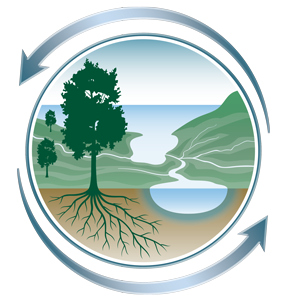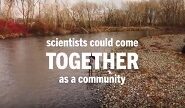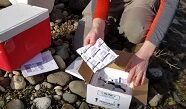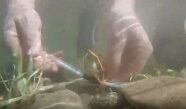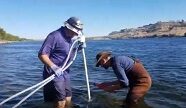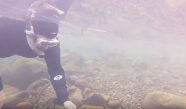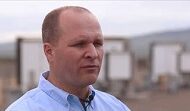Understanding and quantifying the roles of river corridors in watershed function and dynamics
Project website | Overview brochure PDF
- Principal investigators: Tim Scheibe, Xingyuan Chen, and James Stegen
- Annual reports: 2023 | 2022 | 2021 | 2019 | 2018 | 2016 | 2015 (Note: Reports are not issued during review years.)
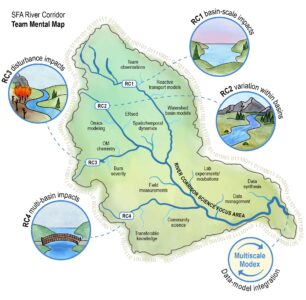
Yakima River Basin (YRB). The Yakima River drains 15,900 km2 (6,150 mi2) of south central Washington State, from the crest of the Cascade mountains east to the Columbia River. Streams and rivers with a wide range of sizes comprise the drainage network and traverse diverse ecosystems, including forested headwaters, shrub-steppe deserts, and rich agricultural lands. Many watersheds within the YRB are highly susceptible to disturbance by wildfires, and the watershed function is also strongly influenced by snowpack, snowmelt, and a system of managed reservoirs. This image represents the SFA organizational structure and team vision, with four research campaigns (RCs) represented as major tributaries within the YRB, and the multiscale model-experiment (ModEx) activity representing the integration of data and models across the four RCs.
Exchange of water between rivers and the surrounding subsurface environment is a vital aspect of watershed function. These hydrologic exchange flows stimulate biogeochemical activity in the subsurface adjacent to the river channel through provision of nutrients, mixing of dissolved reactants, and exposure to microbes. They also modulate water temperatures and thus play a key role in water quality, nutrient dynamics, and energy and material fluxes.
There is strong evidence that river corridor hydrobiogeochemical processes are highly variable among different stream orders and climatic, ecological, and geographical settings; these processes are also hypothesized to be highly sensitive to various environmental and anthropogenic disturbances including floods, droughts, wildfire, land-use changes, and water use and management. A science focus area (SFA) led by Pacific Northwest National Laboratory (PNNL) aims to predict river corridor and watershed system responses to disturbances at scales relevant to national water challenges. The SFA is supported by the Department of Energy’s (DOE) Biological and Environmental Research (BER) program as part of BER’s Environmental System Science (ESS) program.
The SFA is performing integrated experimental, observational, and modeling studies over various settings and scales within the Yakima River Basin in the Pacific Northwest. The transferability of these study outcomes is being evaluated through broad community collaboration across the contiguous United States and globally. Research activities within the SFA focus on understanding coupled hydrologic and biogeochemical processes in the river corridor—which include the surface water channel and other functionally connected features such as the hyporheic zone, near-shore groundwater aquifer, and riparian zone—and quantifying their cumulative effects at watershed and basin scales.
Key Scientific Questions
River Corridor and Watershed Hydrobiogeochemistry SFA researchers are developing mechanistic understanding of coupled hydrologic and biogeochemical processes across a wide range of river corridor and watershed settings and translating that understanding into multiscale numerical models. Key questions include:
- How do hydrologic exchange flos, organic matter chemistry, microbial activity, and watershed disturbances interactively influence river corridor hydrobiogeochemical function and dynamics from reaction to basin scales?
- How can mechanisms that govern river corridor hydrobiogeochemistry be efficiently and sufficiently represented in integrated land surface models at scales relevant to regional and national water challenges?
Translating Process Understanding Across Scales
SFA research includes fundamental process identification and quantification, integration of modeling and experimentation at multiple spatial scales, and implementation of a novel and computationally efficient multiscale modeling framework. This framework incorporates new process understanding into detailed mechanistic models. These models, combined with spatially distributed observational data, are used to formulate simplified or surrogate models applicable at system scales. Accordingly, research activities are organized and coordinated through an iterative learning cycle of integrated models and experiments.
Watershed Disturbances

Carlton Complex Wildfire. This lightning-sparked wildfire in the northwestern Columbia River Basin was the largest wildfire in Washington state history. [Washington Department of Natural Resources]
Open Watershed Science by Design
Fully understanding the functioning and dynamics of large and complex watersheds like the Yakima River Basin is intractable for individual researchers or even a single research team. Through intentional application of open science principles [e.g., findable, accessible, interoperable, and reusable (FAIR) data and integrated, coordinated, open, and networked (ICON) science], the SFA is enabling and partnering with a research community that can more effectively solve large scientific challenges. For example, the Worldwide Hydrobiogeochemical Observation Network for Dynamic River Systems (WHONDRS) is stewarded and coordinated by SFA scientists. WHONDRS is a global consortium of researchers that aims to understand river corridor hydrobiogeochemical function across a wide range of geographical settings. The consortium is developing new instrumentation and protocols for sample collection that will extend new process understanding to river corridor and watershed systems worldwide.
As of March 2022, 20 community data packages have been openly published in DOE’s Environmental Systems Science Data Infrastructure for a Virtual Ecosystem (ESS-DIVE) data repository (data.ess-dive.lbl.gov/portals/WHONDRS/Data). The SFA is combining ICON science principles, crowdsourced data generation through WHONDRS, the model-experiment (ModEx) process of iterative data-model integration, and advanced machine learning (ML) in the ICON-ModEx effort. In this work SFA scientists are partnering with Parallel Works Inc. through a DOE Small Business Innovation Research grant to generate ML models of river respiration based on data from the 2019 WHONDRS summer campaign. Those models are then used to extrapolate predictions to other locations around the United States and assess model uncertainties.
Based on engagement with the scientific community through a series of virtual workshops, SFA scientists established a process for prioritizing new sample locations, identified volunteer collaborators to collect samples, and selected analyses to perform on samples. After an initial round of sample collection and analysis, ML models were updated (i.e., retrained) based on the expanded dataset and predictions were revised, leading to changes in site prioritization and selections of a second round of sampling locations. This iterative process of crowdsourced data collection and updated models and predictions is being cycled monthly. Model improvements and changes in site prioritization over these iteration cycles are being documented, and the updated models will provide improved inputs for process-based watershed models of integrated river corridor biogeochemistry.
ICON-ModEx Activity Map. September 2022 iteration of the ICON-ModEx study. Blue icons represent the high-priority sampling locations based on machine learning (ML) model predictions and uncertainties. Yellow icons represent the sites that have been sampled by crowdsourced collaborators, and orange icons represent sites scheduled for future sampling. Gray icons are sites that were previously considered high priority but have been reduced in priority following ML model updates based on new sample data. Red icons indicate locations where time series data are being collected.
Videos
Mapping Underwater Chemical Activities
Researchers at PNNL re-engineered a technique known as electrical resistivity tomography to study waterway interactions. (2020)

WHONDRS Research Consortium
Overview of the aims and goals of the WHONDRS research consortium. (2019)
WHONDRS Surface Water Sampling Protocol
Demonstrates protocol for a global-scale community-enabled study of surface water metabolomics led by WHONDRS (2019)
WHONDRS Diel Cycling Study Protocol
Demonstrates protocol for 48-hour Diel Cycling Study for WHONDRS (2018)
New Hydrobiogeochemistry Sensor in River Corridors
New sensor technology for estimating the mass flux of water through subsurface sediments in dynamic systems. (2018)
Multidisciplinary Instrumentation and Modeling
Details of a Columbia River experiment to help predict hydrobiogeochemical function under future environmental conditions. (2017)
Real-time 4D Subsurface Imaging
2016 R&D 100 Award-winning imaging technology that enables researchers—for the first time—to take four-dimensional views of the subsurface. (2016)
